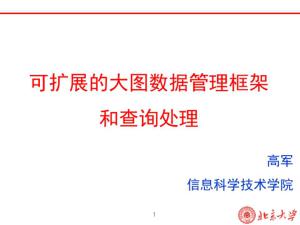- 本月热门
-
 如何成为一名前端开发工程师 by 姜赟
如何成为一名前端开发工程师 by 姜赟 -
 mongoDB入门简介-Java篇: Strongly Typed Languages and Flexible Schemas
mongoDB入门简介-Java篇: Strongly Typed Languages and Flexible Schemas -
 移动APP测试的22条军规 by 黄勇@ThoughtWorks
移动APP测试的22条军规 by 黄勇@ThoughtWorks -
 前端自动化测试实践 by 马逸清@七牛
前端自动化测试实践 by 马逸清@七牛 -
 酷狗前端内嵌页发展史 by 杜剑峰(浏览器版本兼容及性能问题解决办法)
酷狗前端内嵌页发展史 by 杜剑峰(浏览器版本兼容及性能问题解决办法) -
 游戏开发中的图形手势识别和音频处理 by 大城小胖
游戏开发中的图形手势识别和音频处理 by 大城小胖 -
 分布式存储的元数据设计 by 李道兵@七牛
分布式存储的元数据设计 by 李道兵@七牛 -
 Node Profiler 一款JavaScript的性能调优工具 by 朴灵
Node Profiler 一款JavaScript的性能调优工具 by 朴灵 -
 可扩展的大图数据管理框架和查询处理 by 高军@北京大学
可扩展的大图数据管理框架和查询处理 by 高军@北京大学 -
 An introduction to MongoDB by Rácz Gábor
An introduction to MongoDB by Rácz Gábor
加收藏
中国龙经济减速对欧美受影响 The Dragon Economy slows-Implications for the UK & the world economy by Marcus Wright
第1页
The Dragon Economy slows Implications for the UK & the world economy
Marcus Wright RBS Economics August 2015
Marcus Wright RBS Economics August 2015
第2页
China’s slowdown has been on the cards for a while
China’s economic growth has been unprecedented in scale & duration. But this well trodden path of investment-based growth has been seen before. China’s issue is it looks to have gone too far.
Investment as a share of national income (%)
50%
China (1996-2013) Japan (1955-1985)
40% S. Korea (1976-2006)
30%
20% 1
11 Years 21
Source: Macrobond 2
China’s economic growth has been unprecedented in scale & duration. But this well trodden path of investment-based growth has been seen before. China’s issue is it looks to have gone too far.
Investment as a share of national income (%)
50%
China (1996-2013) Japan (1955-1985)
40% S. Korea (1976-2006)
30%
20% 1
11 Years 21
Source: Macrobond 2
第3页
The China checklist – what’s happening?
1. Downward pressure on growth
2. Depressed rates of world trade growth
3. Downward pressure on inflation
4. Global interest rates likely lower for longer 5. Strained financial links to China
?
6. An all-out credit crunch in China
?
1. Downward pressure on growth
2. Depressed rates of world trade growth
3. Downward pressure on inflation
4. Global interest rates likely lower for longer 5. Strained financial links to China
?
6. An all-out credit crunch in China
?
第4页
China’s growth is slowing fast, however you measure it
China appears to be slowing more than the headline figures suggest. The growth prospects of commodity producing countries & other emerging markets with close ties to China have been damaged.
0 1997
GDP Growth Proxy - Y/Y Change GDP Y/Y Change
2003 2006 2009 2012
Source: Bloomberg, Macrobond, RBS Economics 4
China appears to be slowing more than the headline figures suggest. The growth prospects of commodity producing countries & other emerging markets with close ties to China have been damaged.
0 1997
GDP Growth Proxy - Y/Y Change GDP Y/Y Change
2003 2006 2009 2012
Source: Bloomberg, Macrobond, RBS Economics 4
第5页
A big reason why world trade is so bad right now
40% Emerging Asia Import Volume (% Y/Y Change)
30%
20% China induced
slowdown?
10%
0%
-10%
-20%
Post-Tech Bubble
-30%
Asian Financial Crisis
Slowdown
1995 1998 2001 2004 2007
Global Financial Crisis
2010 2013
Source: Netherlands CPB 5
40% Emerging Asia Import Volume (% Y/Y Change)
30%
20% China induced
slowdown?
10%
0%
-10%
-20%
Post-Tech Bubble
-30%
Asian Financial Crisis
Slowdown
1995 1998 2001 2004 2007
Global Financial Crisis
2010 2013
Source: Netherlands CPB 5
第6页
Yuan devaluation - the cherry on the disinflationary sundae
Emerging Market Currencies
South Africa Mexico
Malaysia Russia India Poland Brazil
Indonesia China
-30 Increasingly
'under-valued'
Increasingly 'over-valued'
Causes of Inflation Variability in 80 Advanced Economies (%) 60 40 20
0 1971-85 1986-98 1999-2013
Common factor Chinese export prices
• Yuan devaluation has grabbed the headlines recently. But it is not yet the big story.
• China has been exporting disinflation for a while now. And it is becoming more and more of an influence on world prices.
Source: Macrobond, BIS 6
Emerging Market Currencies
South Africa Mexico
Malaysia Russia India Poland Brazil
Indonesia China
-30 Increasingly
'under-valued'
Increasingly 'over-valued'
Causes of Inflation Variability in 80 Advanced Economies (%) 60 40 20
0 1971-85 1986-98 1999-2013
Common factor Chinese export prices
• Yuan devaluation has grabbed the headlines recently. But it is not yet the big story.
• China has been exporting disinflation for a while now. And it is becoming more and more of an influence on world prices.
Source: Macrobond, BIS 6
第7页
Global interest rates lower for longer
Number of months from 1st rate hike to
first rate cut
Canada (Jun-10) Iceland (Sep-11) Norway (Nov-09)
Israel (Aug-09) Australia (Oct-09)
Korea (Jul-10) Poland (Jan-11) Hungary (Nov-10)
Chile (Jun-10) Sweden (Jul-10) N.Zealand (Mar-14) N. Zealand (Jun-10) Eurozone (Apr-11) Denmark (Apr-11) Turkey (Jan-14)
9 7 7 4
26 25 25 24 22 21 19 17 15
55 38
All of these OECD central banks have raised rates since the financial crisis. All have had to lower them again.
Source: Bloomberg, Macrobond 7
Number of months from 1st rate hike to
first rate cut
Canada (Jun-10) Iceland (Sep-11) Norway (Nov-09)
Israel (Aug-09) Australia (Oct-09)
Korea (Jul-10) Poland (Jan-11) Hungary (Nov-10)
Chile (Jun-10) Sweden (Jul-10) N.Zealand (Mar-14) N. Zealand (Jun-10) Eurozone (Apr-11) Denmark (Apr-11) Turkey (Jan-14)
9 7 7 4
26 25 25 24 22 21 19 17 15
55 38
All of these OECD central banks have raised rates since the financial crisis. All have had to lower them again.
Source: Bloomberg, Macrobond 7
第8页
Greece has grabbed all the headlines. It shouldn’t.
Greece Spain Italy
Ireland France
US Germany
China
Change in UK financial sector exposure
(2009 - 2015)
-100% 0% 100% 200% 300% 400%
• While the UK has decreased its financial exposure to most countries since the crisis, loans to China have skyrocketed.
Global Banking Sector Exposure 1,000 to Greece and China ($ Bn)
Greece 500 China
2005 2007 2009 2011 2013
• The world’s attention has been focussed on Greece. But the world’s banking sector is 17 times more exposed to China. And that is before we count exposure to Hong Kong.
Source: BIS, Macrobond 8
Greece Spain Italy
Ireland France
US Germany
China
Change in UK financial sector exposure
(2009 - 2015)
-100% 0% 100% 200% 300% 400%
• While the UK has decreased its financial exposure to most countries since the crisis, loans to China have skyrocketed.
Global Banking Sector Exposure 1,000 to Greece and China ($ Bn)
Greece 500 China
2005 2007 2009 2011 2013
• The world’s attention has been focussed on Greece. But the world’s banking sector is 17 times more exposed to China. And that is before we count exposure to Hong Kong.
Source: BIS, Macrobond 8
第9页
An impending credit crunch?
China’s banking sector is sitting on problem loans far in excess of official figures. Other countries’ experiences suggests it could be in for something worse than a slowdown.
120% 80% 40%
Rise in private sector
104% 105%
credit as % of GDP in the six years to.....
82%
52% 60% 42% 42% 24% 32%
0%
Indon. - US - Japan - S. Korea UK - Sweden China - Thailand Ire 1997 2009 1992 - 1997 2009 - 1990 2014 - 1997 2007
Source: Macrobond, IMF 9
China’s banking sector is sitting on problem loans far in excess of official figures. Other countries’ experiences suggests it could be in for something worse than a slowdown.
120% 80% 40%
Rise in private sector
104% 105%
credit as % of GDP in the six years to.....
82%
52% 60% 42% 42% 24% 32%
0%
Indon. - US - Japan - S. Korea UK - Sweden China - Thailand Ire 1997 2009 1992 - 1997 2009 - 1990 2014 - 1997 2007
Source: Macrobond, IMF 9
第10页
Follow us on Twitter
@RBS_Economics
https://twitter.com/rbs_economics
Or visit us online
@RBS_Economics
https://twitter.com/rbs_economics
Or visit us online
第11页
Disclaimer
This material is published by The Royal Bank of Scotland plc (“RBS”), for information purposes only and should not be regarded as providing any specific advice. Recipients should make their own independent evaluation of this information and no action should be taken, solely relying on it. This material should not be reproduced or disclosed without our consent. It is not intended for distribution in any jurisdiction in which this would be prohibited. Whilst this information is believed to be reliable, it has not been independently verified by RBS and RBS makes no representation or warranty (express or implied) of any kind, as regards the accuracy or completeness of this information, nor does it accept any responsibility or liability for any loss or damage arising in any way from any use made of or reliance placed on, this information. Unless otherwise stated, any views, forecasts, or estimates are solely those of RBS’s RBS Economics Department, as of this date and are subject to change without notice. The classification of this document is PUBLIC. The Royal Bank of Scotland plc. Registered in Scotland No. 90312. Registered Office: 36 St Andrew Square, Edinburgh EH2 2YB. The Royal Bank of Scotland plc is authorised by the Prudential Regulation Authority and regulated by the Financial Conduct Authority and the Prudential Regulation Authority. © Copyright 2015 The Royal Bank of Scotland Group plc. All rights reserved
This material is published by The Royal Bank of Scotland plc (“RBS”), for information purposes only and should not be regarded as providing any specific advice. Recipients should make their own independent evaluation of this information and no action should be taken, solely relying on it. This material should not be reproduced or disclosed without our consent. It is not intended for distribution in any jurisdiction in which this would be prohibited. Whilst this information is believed to be reliable, it has not been independently verified by RBS and RBS makes no representation or warranty (express or implied) of any kind, as regards the accuracy or completeness of this information, nor does it accept any responsibility or liability for any loss or damage arising in any way from any use made of or reliance placed on, this information. Unless otherwise stated, any views, forecasts, or estimates are solely those of RBS’s RBS Economics Department, as of this date and are subject to change without notice. The classification of this document is PUBLIC. The Royal Bank of Scotland plc. Registered in Scotland No. 90312. Registered Office: 36 St Andrew Square, Edinburgh EH2 2YB. The Royal Bank of Scotland plc is authorised by the Prudential Regulation Authority and regulated by the Financial Conduct Authority and the Prudential Regulation Authority. © Copyright 2015 The Royal Bank of Scotland Group plc. All rights reserved
